Just a warning - this is a long, image heavy post (though they'll be small in kb...). However, I think it will be worth it. I hope you all agree!
What is a logic model?
A logic model is a simplified chart that gives you an overview of a program. In my line of work, we are frequently evaluating a program that is designed to, for example, help teachers teach better. This model is just as applicable to business (in fact, it originated in business). Basically, a logic model gives an overview of your business while clearly showing the connections between what you are investing in your business, what outputs you are producing, and what your short term and long term goals are. By putting this in chart form, it helps you see how what you are doing relates to your goals - when you've done it "right," all of our inputs and outputs will relate to your goals - you'll have goals associated with each, and no goals that can't be connected to something you are inputting or producing.
What are the components of a logic model?
A simple logic model has three components: inputs, outputs and outcomes.
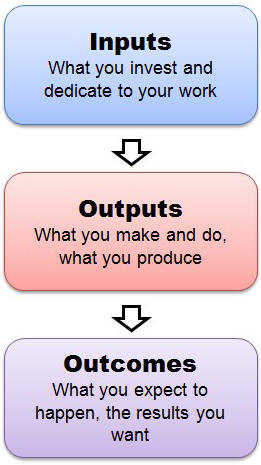
Inputs reflect all of the components that you put in to what you are making. The outputs are all of the activities that you will engage in, and also in many cases who you will be targeting/including in your efforts. Lastly, outcomes are what you expect to have happen. This model is excellent for the sort of simple things that come up in our daily lives all the time. For example, perhaps you come home to the problem that your plants are drooping. At this point, the input would be water and fertilizer. The output would be the activities - measuring out the fertilizer, mixing it with the water, and watering your plants. The expected outcome would be that the plant leaves would no longer droop, and the plant would no longer need water (at least until next time!)
A full logic model has a few other components.
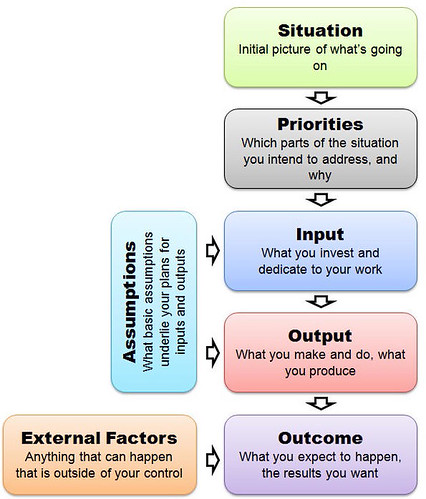
This adds in the situation - what is the initial condition of things at the time that you start pondering all the rest? Priorities - namely, of all of the different aspects of your situation, what are you going to target? It also includes assumptions - what things are you believe to be the case that influence your consideration of inputs and outputs? And finally, external factors are all of those things that can happen that will influence the outcomes. So, to continue the plant example, the situation was that the plant leafs are drooping. To this, you can add in some of your own knowledge - the plants haven't been watered in a week or fertilized in a month. Since it's been so long, you prioritize conducting both activities - watering and fertilizing. After a careful examination of the situation, you proceed with the assumption that water and fertilizer will solve the problem (rather than that the problem is with the type of soil, or the current light source, or the draft by your window - all of which are the potential external factors).
Again - this is still all pretty hypothetical, so I constructed a very simple logic model. You see, the thing is, we actually all use logic models all the time to make decisions, we just don't think about it. The plant example is one like this. I know, as an indoor planter, I go through that all the time, but I never would lay it out like that, I'd just go get the water. Here's another, slightly more complex example.
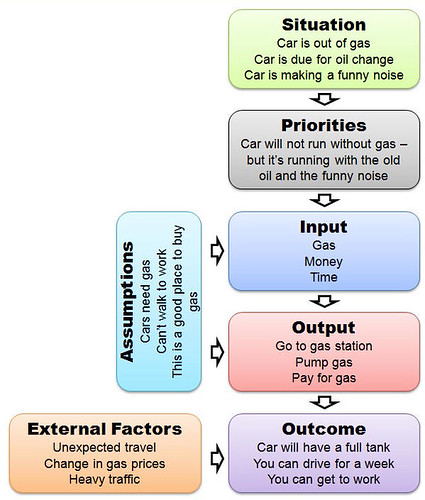
Again - we all do this automatically when it comes to simple situations. If we feel hungry, we go to the kitchen and get food out of the fridge (unless our priority is our diet!) Indeed, in life this can get very complex - looking at the situation of our life, we determine how to spend our money based on our priorities, and the inputs and outputs are determined by the priorities, situation, and assumptions we make - but sometimes the outcomes don't work out as we expected because of external factors outside of our control! So maybe you put the gas in the car, use up the money, and even though you expect this means you can get to work for the next week, that funny noise you ignored means that the car breaks down, or you hit heavy traffic that eats through the gas, or your office schedules you for a meeting in another state.
So! That's what it looks like when a logic model is simple. Lets make this a little bit more applicable to our craft business. I want to created a hypothetical business, Widget Co., with the idea that I will make - obviously - widgets, a strange item of indeterminate function that I believe everyone needs. I want to make Widget Co. the best widget company in the world!
Why am I using a hypothetical company instead of CCC?
Pretty simple - with a hypothetical, I can control all of the factors, rather than worry about all of the different factors that influence my business - especially, for example, that I work in two different and distinct fields (crochet and photography).
So lets go! Let's say that here's my situation:
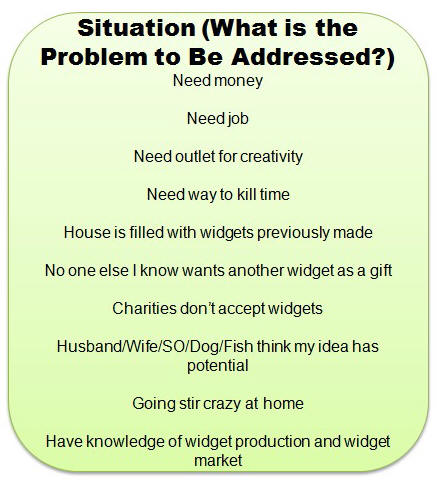
Obviously, a real situation will be much more complicated than this. :) But the idea is, identify what it is that you are actually trying to impact by going about whatever endeavor you are going about. When considering the situation, consider: what are the problems? Why are these problems? Who has a stake in the situation? What are the different factors that influence the situation? What are the political, social, environmental, familial, economic, or other factors that influence the situation? Are there activities that you can engage in to learn more about the situation before you proceed? And keep in mind - logic models take time to develop! So, for example, it's taken me about two hours to put together this post - which is nothing! - and thus it's not surprising that it just dawned on me that I should have included "No other companies currently make widgets" to my list of the situation!
But of course, you'll never be able to hit all of the problems with one solution. Instead, prioritize, prioritize, prioritize!
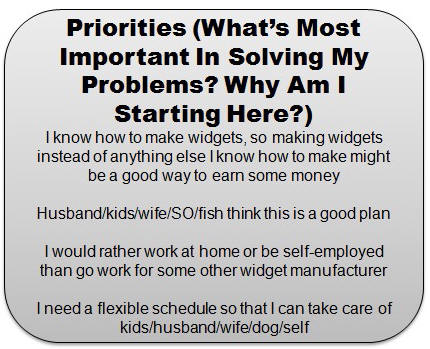
When you set the priorities, consider all of the different factors that relate to why you might make the decision that you make. Who else is affected? Who will be involved in making the decisions? Are there specific criteria for picking your priorities? Why have you picked these priorities? The reasons you have chosen the priorities that you make will impact your desired outcomes. In my example, I've prioritized making money as one thing - so presumably one of my expected outcomes will be profit, or else I've done something wrong! But the list I gave above is just a short sample of the many priorities that you might have.
Next up is the assumptions. Here's only a small selection of the possible list of assumptions that would impact this model:

I could as well indicate many others - but these can be especially hard to identify, precisely because they ARE assumptions. They underlie every decision we make to such an extent that it can be hard to realize that we are even taking them for granted. Talking to others about your business - those who are on the outside and don't know much - can help to single out these assumptions.
Alright. You've got the foundation! So what, exactly, will it take to make widgets?

Here's just a preliminary list of the kinds of inputs that it will take to produce a widget. Note that inputs are always things that are tangible (even if not physical). Time, expertise, money, materials, space - these are inputs. The kinds of things that might be a line item on a budget are inputs.
So, now we've got the raw materials and other bits and pieces that we'll be using. But what is our output - what is our process? - that will be utilizing these inputs?

Ideally, each of these outputs will match to one (or more) of your inputs. So, make widgets connects directly to time, money, and materials. Sell widgets connects directly to space. If you've got an input that doesn't lead to an output, you've got a problem; if you've got an output that doesn't derive to an input, you've got a problem. Don't read my example to closely - I've probably got at least one unpaired, because I put this together so (relatively) quickly, and using a fake example. :)
Another important component of the outputs is who this impacts. Yes, this makes the vocabulary a bit weird - we don't generally think of our audience/participants as being "outputs" but think of it another way - if our product is a widget, than a person who owns a widget is an output - something we have "created" by engaging in this behavior. Thus, we have our stakeholders - the external groups that are influenced by our input of materials and output of widgets.

Ideally, we'd have a different vocab for this - but we don't, so life goes on. :)
Alright! We're almost ready to take a look at what we expect to have happen. But before we do that, take a step back and consider all of the things other than your own inputs and outputs that might influence your business. Here are a few that I came up with:
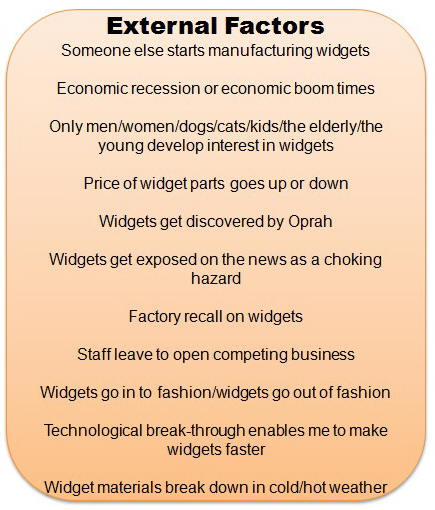
Loads more could be added, though, both good and bad!
Lastly, we've got our outcomes. For a real business, you'll generally divide these in to three categories: short term outcomes, middle term outcomes, and long terms incomes. For this example, I've only done short term and long term.
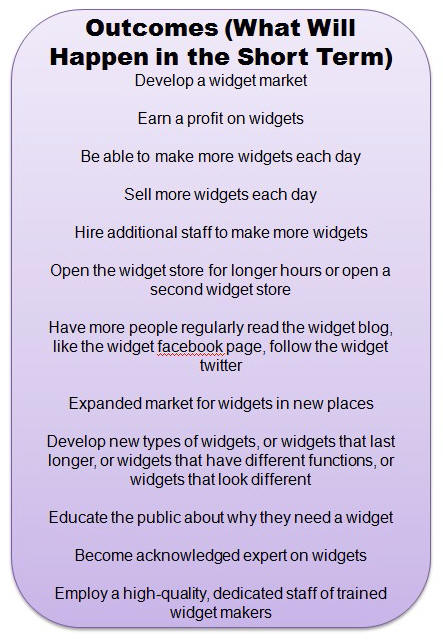
Here, in the short term, is what I am expecting the outcomes to be from my widget business, disregarding the external factors that might end up messing everything up. Short term outcomes should be within reach, reasonable and - and we'll talk about this more tomorrow - measurable.
Long term impacts are where things get ambitious!

However, you'll notice that my long term outcomes for Widget Co. are particularly out there. This is wrong, and I did it wrong on purpose, because it makes an excellent segue into what will be the next post in this series (which probably won't get done tomorrow, just based on how long this one took me I won't have the time - I've been at this for about three hours!!)
Setting outcomes can be hard. The outcomes - both short term and long term - that you set should translate directly in to goals, and the rules that govern what makes a "good" goal are kind of complex but well worth examining, and so I will, in the next post.
Alright, so now we've introduced this, but I bet some of you are asking:
Wow that's a lot of work - why should I bother?
Keep in mind that when you really do this, the different parts all interrelate closely. If you take a step back and list your priorities, then do all the rest and realize that you are engaging in activities that have nothing to do with your priorities, and have other priorities that aren't being met, then you know something new about your business. If you have outcomes that don't link directly to your inputs and outputs, then you need to consider how you can meet that outcome in more detail, and consider how you should change your behavior. If you haven't looked closely at the assumptions that you have made, it can be very difficult (well nigh impossible!) to isolate what has gone wrong when things don't go quite as you expect. I could continue to list examples.
I'm sure that all of us have done something like this, to a lesser or greater extent, for our business. We can't continue to produce our outputs if we don't know what our inputs are! But, for example, I think a lot of us overlook the importance of the time we spent on the internet as a marketing tool - getting the word out about our businesses IS an essential part of our business. When you actually do one, consider listing the items in each category by importance - that'll help you figure out how best to divide your time (which is an input that is ultimately completely limited by the number of hours in the day! ;) ) In short, this is the kind of activity that you'll get out as much as you put it.
Now, to tell you honestly - I've not yet done a logic model for my own business. :) But now that I've really reminded myself of just how useful they can be, I'm definitely going to.
And don't forget - this isn't set in stone! It changes over time, just as our priorities and hoped-for outcomes, input skills and output products, do.
If you want to learn more about logic models, this is a very helpful site. The Teaching and Training guide listed there helped remind me of all the different bits and pieces to include in this post. :)
Until then - I hope this is helpful! :)
Evaluation 101 series:
1. Logic Models
2. Goal Setting
3. Writing Objectives
4. Performance Measures for Dummies
5. Bringing it All Together
No comments:
Post a Comment